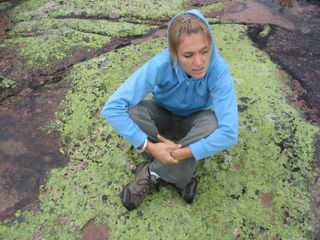
Vicunas grazing in Lauca National Park, Chile
 The church in the center of Parinacota
The church in the center of Parinacota
We traveled through the driest desert in the world called the Atacama and found ourselves in a very pleasing beach town named Arica (I kept thinking everyone was talking about me) where we frolicked around for an afternoon. The next day we crossed back into Peru. Our next stop was the jumping off point for what are known as "poor man's Galopagus islands," more likely to be found on a map under the name of Islas Ballestras. A boat helped us view the beautiful area and we spotted Humbolt Penguins, Peruvian Boobies (these are birds of course!), Peruvian Pelicans, Inca Terns, 3 kinds of Cormorants, sea lions, and dolphins.
He tried to eat D's shoe
Then it was back to Lima to explore the bustling streets, a monastary with catacombs, and the grand squares of crumbling colonialism.
Now we are back home, kayaking and relaxing in the lush beauty of the humid summer we have found here!












